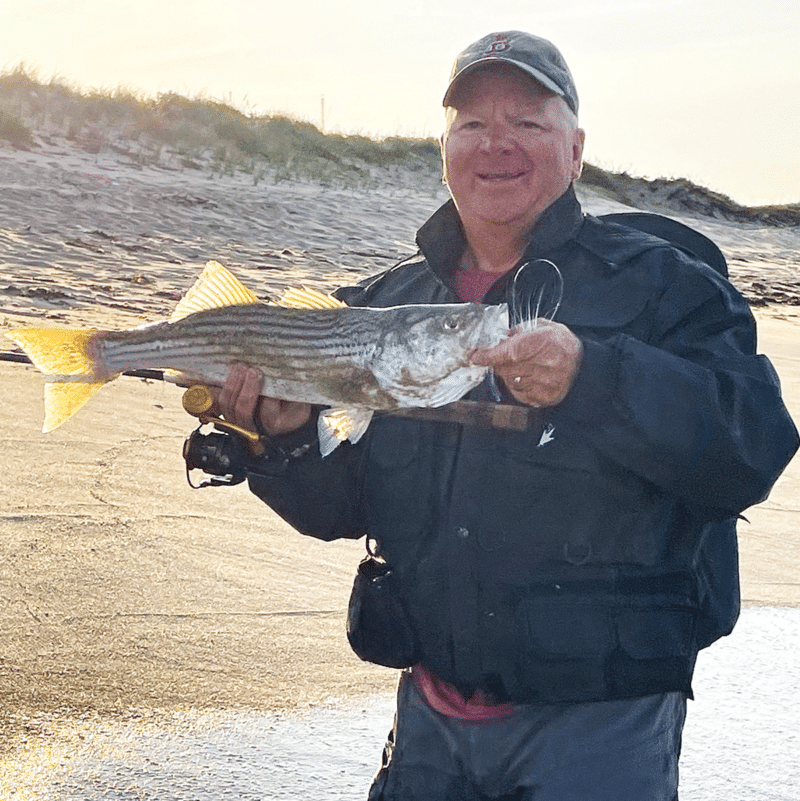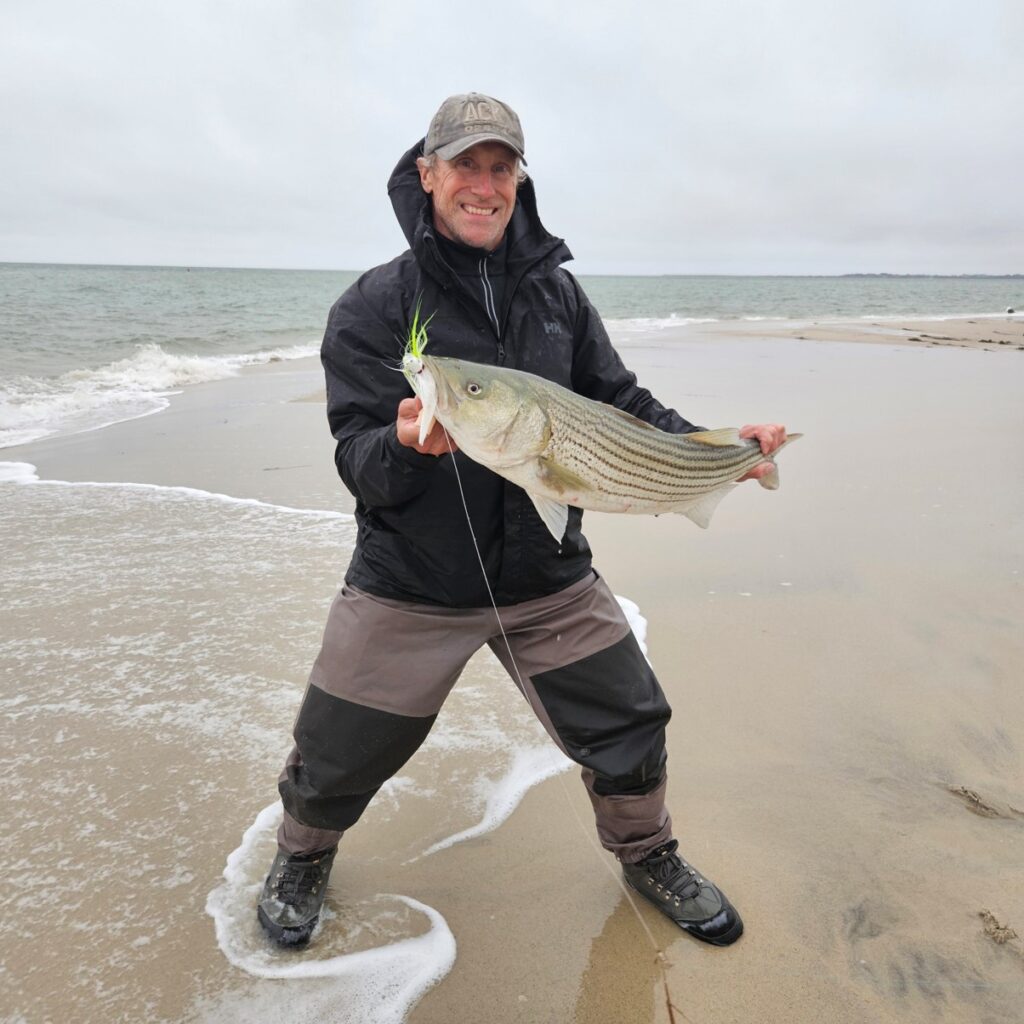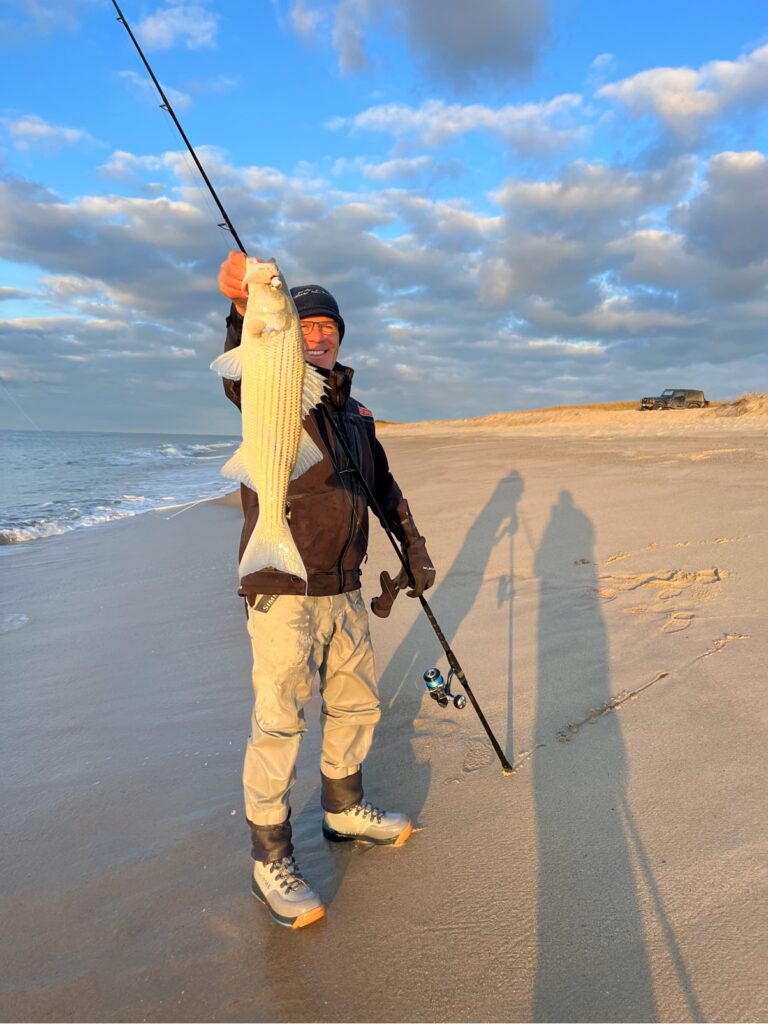by Steve “Tuna” Tornovish
Yikes—it’s the second week of May and no Nantucket anglers have caught a striped bass yet! The first striper of 2023 showed up on May 3. I remember this well as my wonderful, crazy wife Beth landed it! She didn’t know that it was a big deal at the time. I certainly did. So here we are, us Nantucket fishing types, waiting in anticipation. Antici-paaaaaation…it’s keeping me waaaaaaaiting…
Oh yeah—what a great tune that is! Anticipation was Carly Simon’s first big hit. It’s a song that she said she wrote back in 1971. The lovely Ms. Simon said it came together in about 20 minutes while she was waiting for fellow musician Cat Stevens to pick her up for a date. Carly had that crazy hot hippie vibe back then, with the long flowing skirts and the floppy felt hat—hard to imagine that anyone would be late to meet her, right? But we should all be glad that Cat Stevens was, as his tardiness helped spawn a yacht rock classic. I was 10 years old when that song came out, riding around in my mom’s Country Squire station wagon, complete with the wood-grain paneling, listening to WRKO on the AM radio (“68 ‘RKO”—I can still hear the jingle!). Carly’s sweet little song has stood the test of time, aided somewhat by a fairly clever ketchup commercial in the 1980s. The yacht rock genre is a strange phenomenon. I chuckle at the thought and poke fun, yet I know every song and most of the lyrics. My finger never seems to jump to change the channel. Man, I’m getting old…
Enough musical nostalgia—let’s get back to catching some stripers, shall we? This early season fishing is all about getting back to classic lures that have withstood the test of time. For me, that means the bucktail jig. The bucktail is so very simple, yet so effective. The lure, in its most basic form, consists of a chunk of lead molded around a fairly stout hook, dressed up with a variety of deer hair that is fastened to the collar of the hook with strong wraps of heavy gauge thread (usually red in color). The most common bucktail jig has been called the Smiling Bill, with a red mouth painted on the face of the jig. Bucktails come in a wide variety of sizes. They catch almost every fish that swims. The bucktails are so versatile that they were included in the emergency kits packed in the rafts of World War II sailors and airmen as an essential survival tool.
Bucktails look like nothing that fish feed on, specifically, yet they mimic everything in a strange way. From baitfish to sand eels to crabs, the bucktail has just enough similarity to appear like a prime high-protein meal to the striped bass. Bucktails are tipped with a trailer of some sort to give them a bit more fish attracting action as they are retrieved through the surf. The most traditional trailer was the Uncle Josh pork rind strip, dyed a vivid red color. The trailer waves like a fish tail that emerges from the deer hair wrapped around the hook. These days, the trailer possibilities have expanded greatly to include paddle tails made of a variety of soft plastics. The trailers and the dense deer hair slow the descent of the jig in the water. This keeps it in front of the fish.
In my quest to learn more about the appeal of this deceptively simple looking lure, I reached out to three guys who fish with them extensively—Dr. Greg Chotkowski, Rick Ramos, and my dear younger brother Bill Tornovish. These three formed “Go Team Bucktail” and swept the team competition in the 2023 Spring Sea Run Classic fishing tournament. All three of these guys have a reputation for fishing with a maniacal determination. They simply get after the fish.
Dr. Greg filled me in: “Bucktailing is my go-to in the spring and fall. It also produces surprisingly during the summer months when you think there are no stripers around. In the spring, the bass are migratory, and they just show up. Who knows what day that is! These bass are hungry and they are chasing bait fish up and down the shoreline. It is surprising how many bass are caught close to shore, right beyond the lip where the waves break. For this reason, cast distance is not a factor. It is more about maintaining the bucktail in the proper water column to be most effective.”
One of the advantages of the simple bucktail is that the angler can control the presentation of the lure with retrieval speed and rod action. Thus, the lure can linger near the bottom, skip across the surface, or meander in that sweet spot somewhere in between. Greg continues: “You can somewhat regulate this with the weight of the bucktail. For a calm surf, I will start out with a 1- or 1-1/2-ounce bucktail. The goal is to keep the bucktail in the mid-water column in front of the lip. If the bucktail gets pushed above the lip by the surf, then go to a heavier bucktail. You don’t want to use too heavy a bucktail, because you do not want to be dragging this along the bottom. This is where the finesse comes in on the speed of the retrieval and jigging it to keep it off the bottom. Touching the bottom is okay—dragging it through sand is not. This is why bucktailing is great for the beaches of Nantucket. The beaches are mostly sandy bottoms with few obstructions to get hung up on (rocks, weeds, trees).”
Brother Bill learned about the effectiveness of the bucktail when fishing with Greg. He quickly added the new technique to his arsenal, and his catch rate jumped considerably. Bill told me: “Bucktails work on those days when others fishing next to you are getting skunked, especially when the bite is finicky.”
From watching Billy fish next to me (and outcatch me), I notice that he tends to pop his jig up through the water with a quick upwards sweep of his rod and then let the lure fall as he takes up a the slack line. Most of his bites occur as the jig is dropping back down.
The first time that I met the affable Rick Ramos was one early morning at Smith’s Point as we both caught stripers by tossing 3-ounce bucktails into the rip. Rick told me that he has had a long-time connection to the bucktail. It started as a kid, when his dad would take him out hunting for deer. The deer tails were saved and later utilized for fishing lures that his dad hand-poured in the basement during the winter months. Rick caught a lot of stripers with those handtied bucktails. Rick got back into striper fishing in his 30s. “I started fishing the other island, Martha’s Vineyard, where there’s lots of structure and boulder fields. Catching bass there just felt easier than the place we know as the Grey Lady.”
Rick talked with his dad about the lack of solid structure here on Nantucket. “‘Dad, it’s hard here— there’s no structure!’ My father stopped my ‘no structure’ rant and said, ‘Son: tell me how the water is moving. Is there strong current? Tell me about any rips that you’ve found.’ I immediately described spots and scenarios where these patterns appeared. His response was, ‘throw a bucktail.’ Now at that time, I looked at the bucktail like many anglers do: it’s a boat jig; it’s only for bottom fishing; it’s too heavy; and some say it’s boring. My father assured me that it would catch. So I gave it a try on the rips accessible to surfcasters here on Nantucket—in fastmoving, heavy water with a strong wind in my face.
In fact, the only thing that would punch through the wind that day was a 3-ounce bucktail. After a few casts and figuring out my jigging patterns to work the jig in the fast moving water, I connected and quickly developed a rhythm and feel for where the fish were holding. That day was the best outing I’ve had on the Nantucket surf since I’ve started. Of course the obsession began ‘same tide next day,’ and they were there again. I quickly realized that my Pops was right. The bucktail was a fish finder!”
We in the beach fishing community joke that there’s two types of fishermen out there—the “Go bucktails” gang and the “No bucktails” crew. I’ve caught enough nice stripers on the deer hair jigs to know who is right on this one. And for those who eschew the humble bucktail, I say this: You’re so vain, you probably think this article is about you. Now would someone please catch the first beach striper of 2024?
Steve “Tuna” Tornovish is a Nantucket native who
has spent his life fishing from the beaches of his
beloved island. He loves to introduce clients to
the joy of fishing with his Nantucket Island Fishing
Adventures: stevetuna.com





